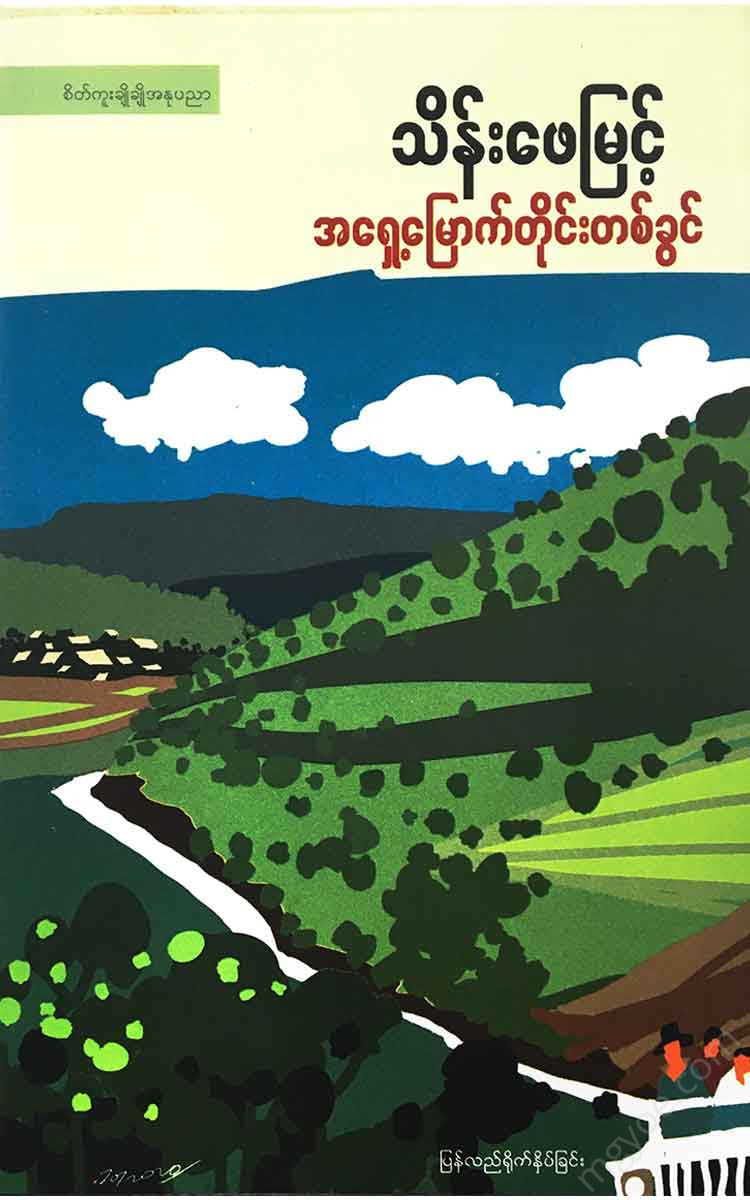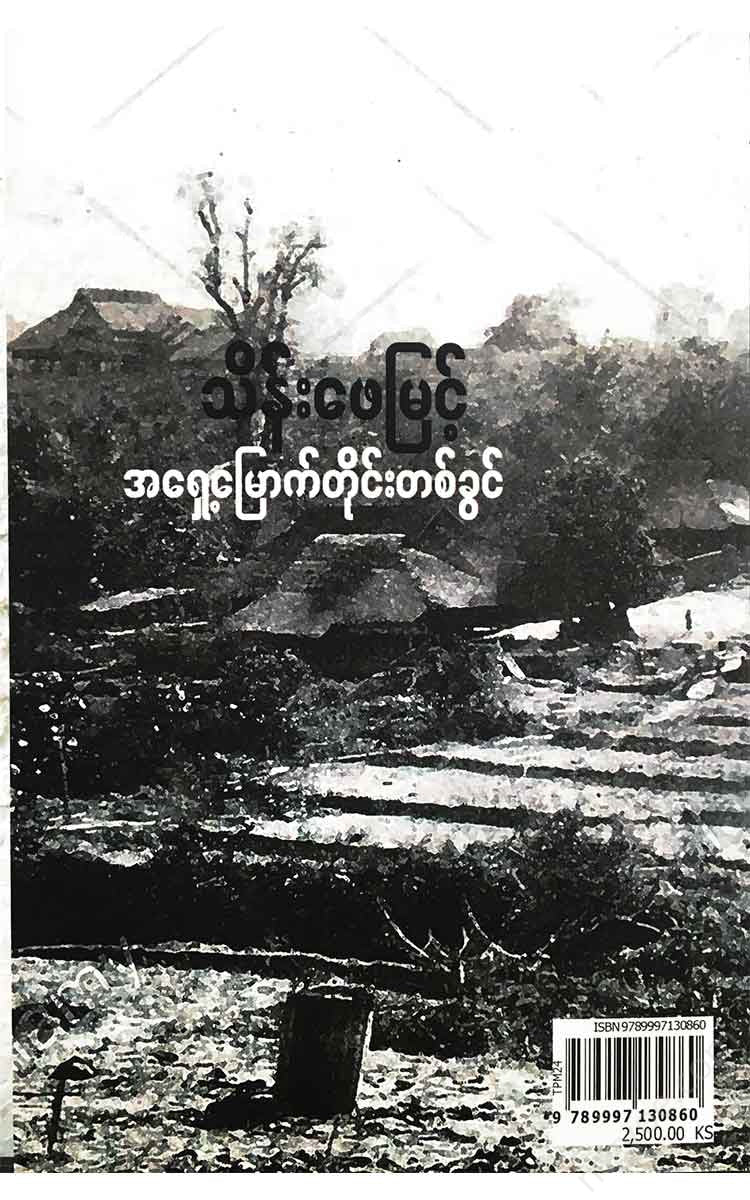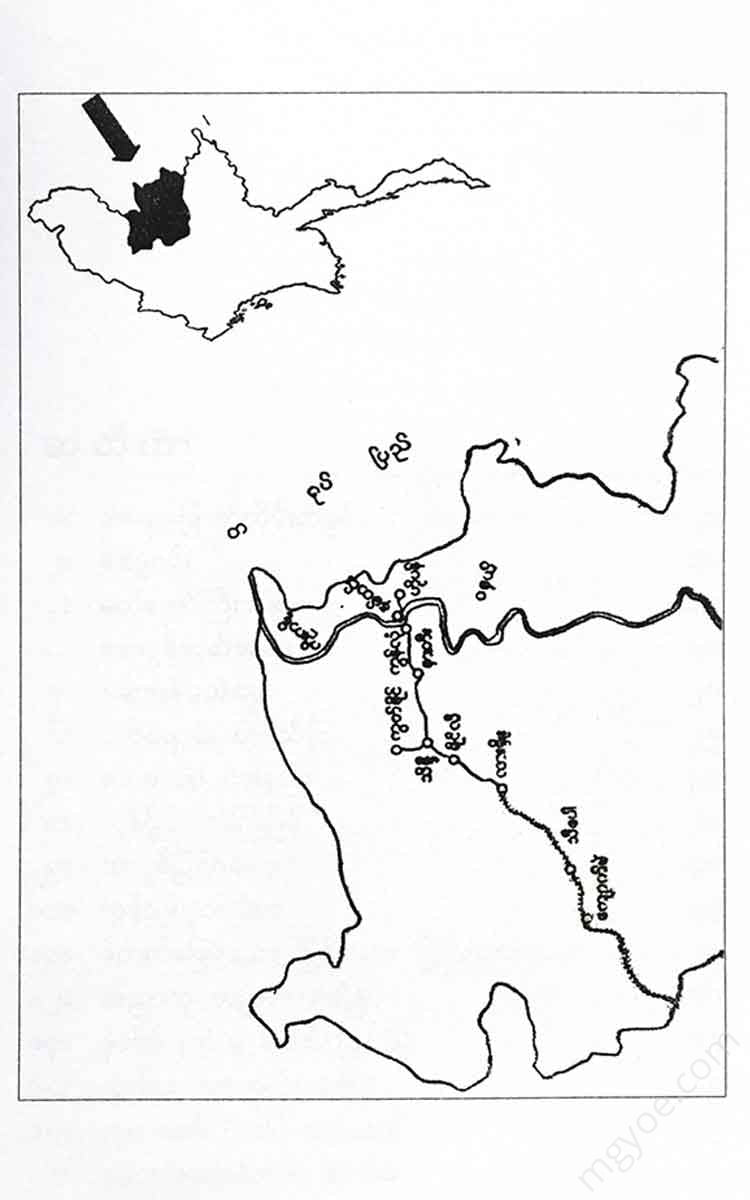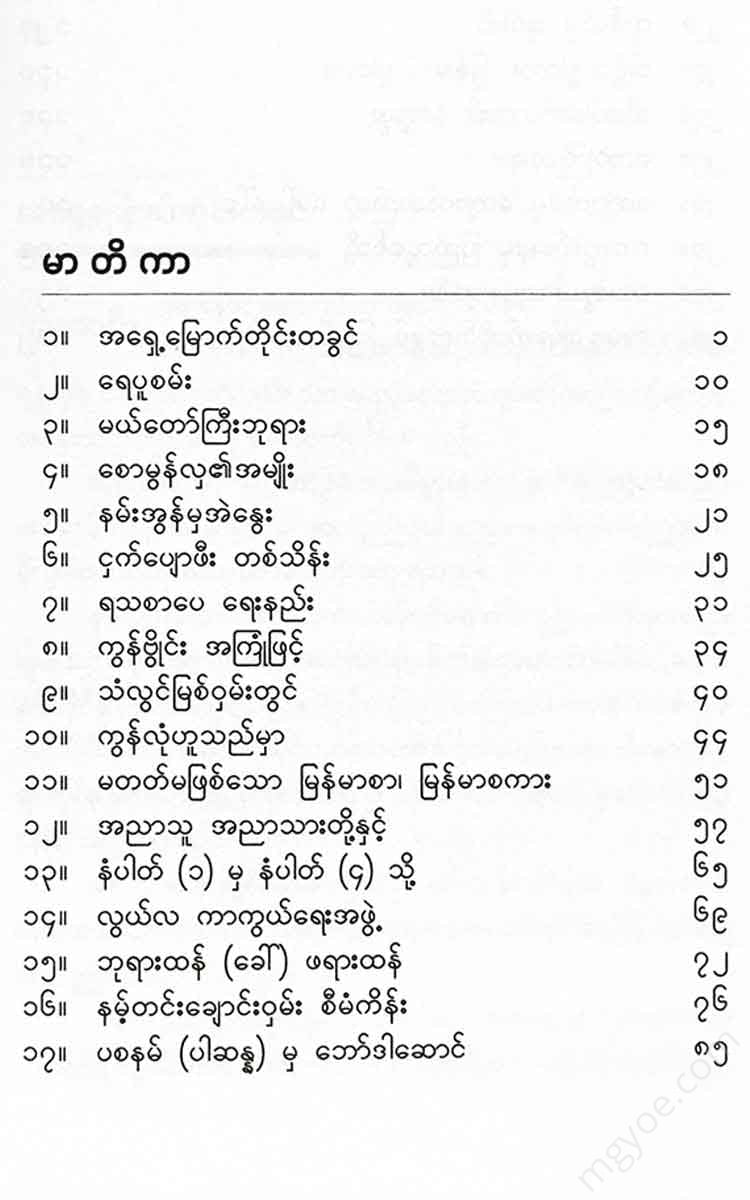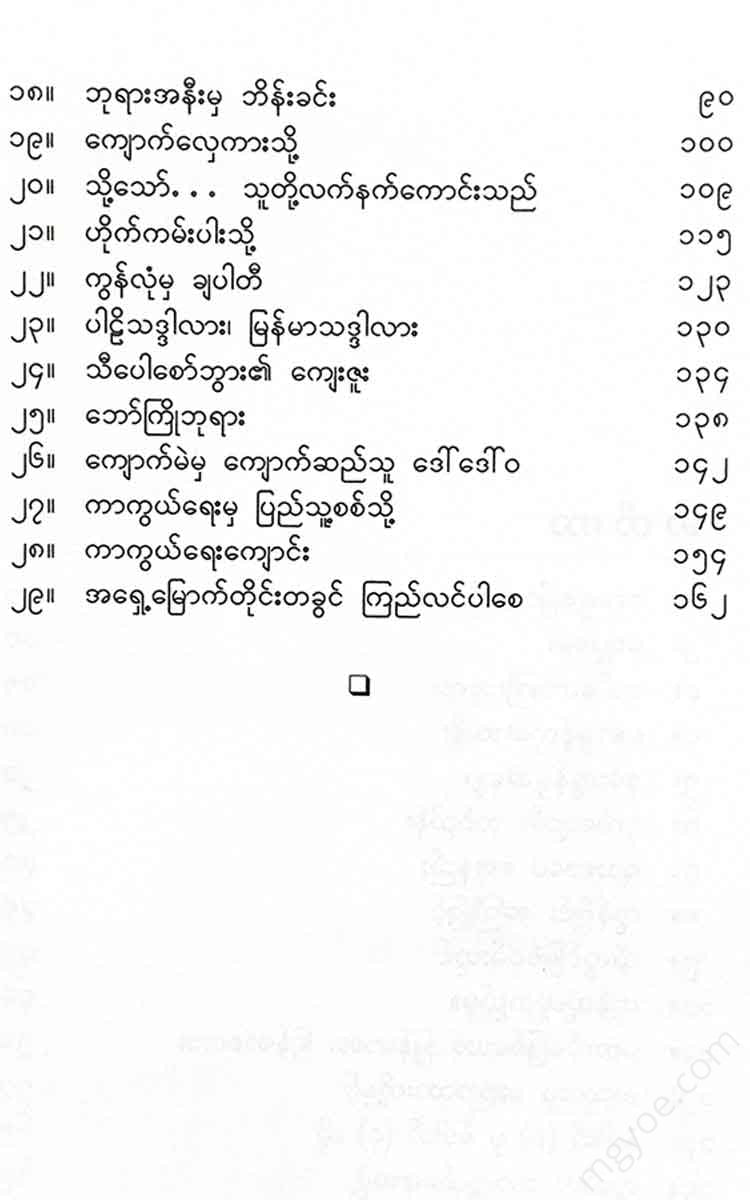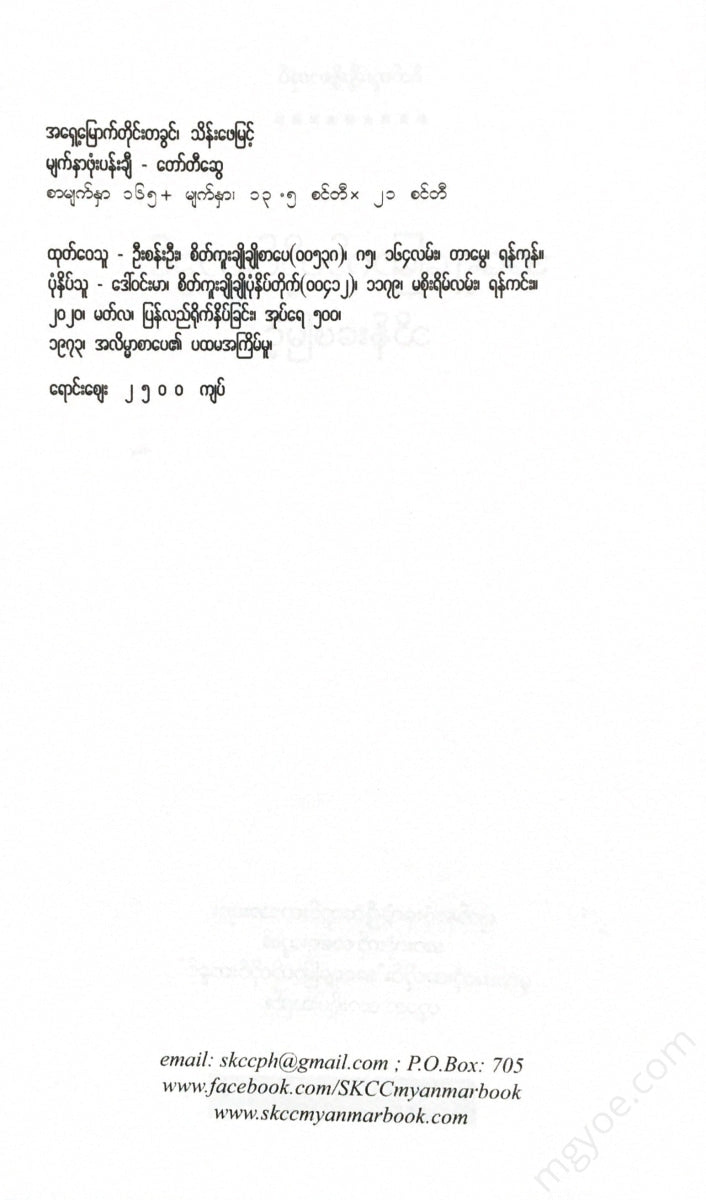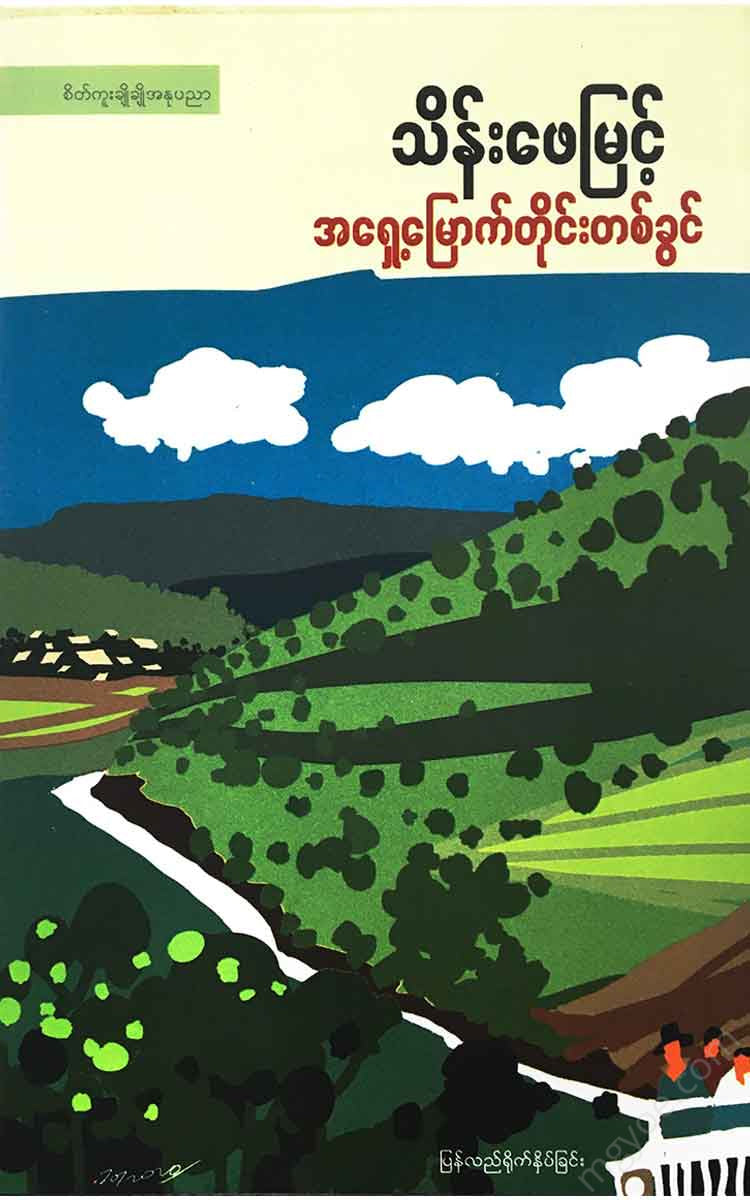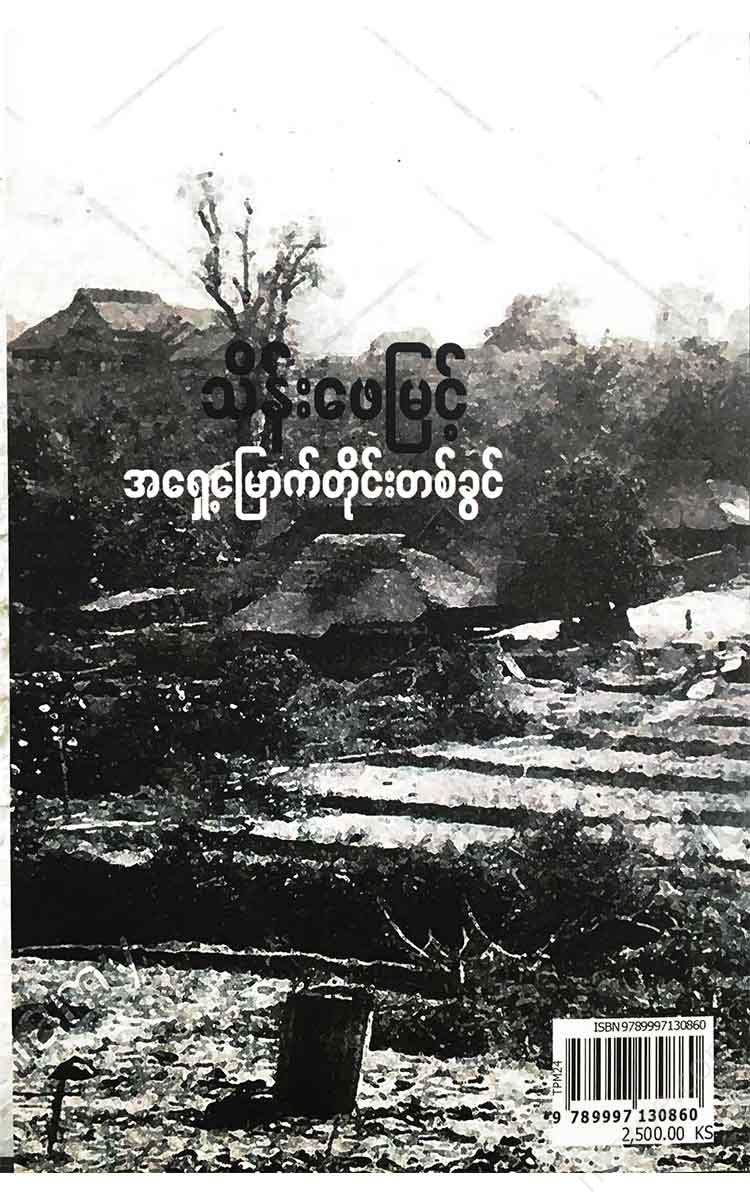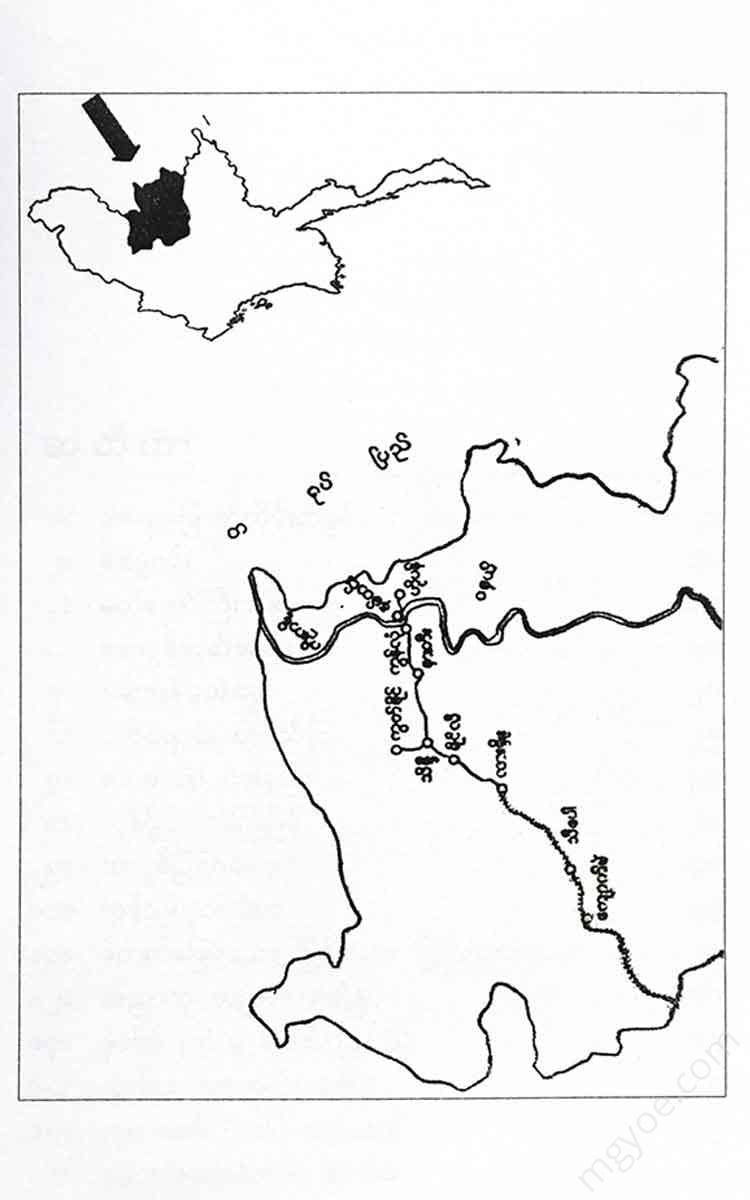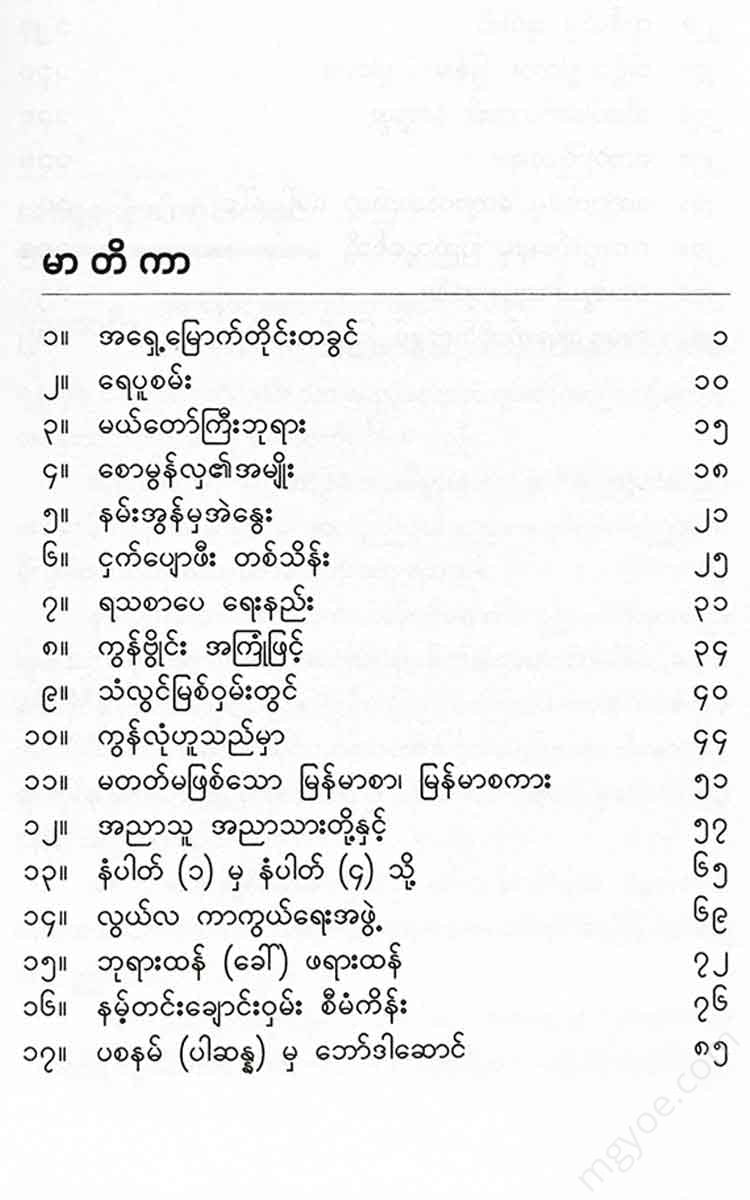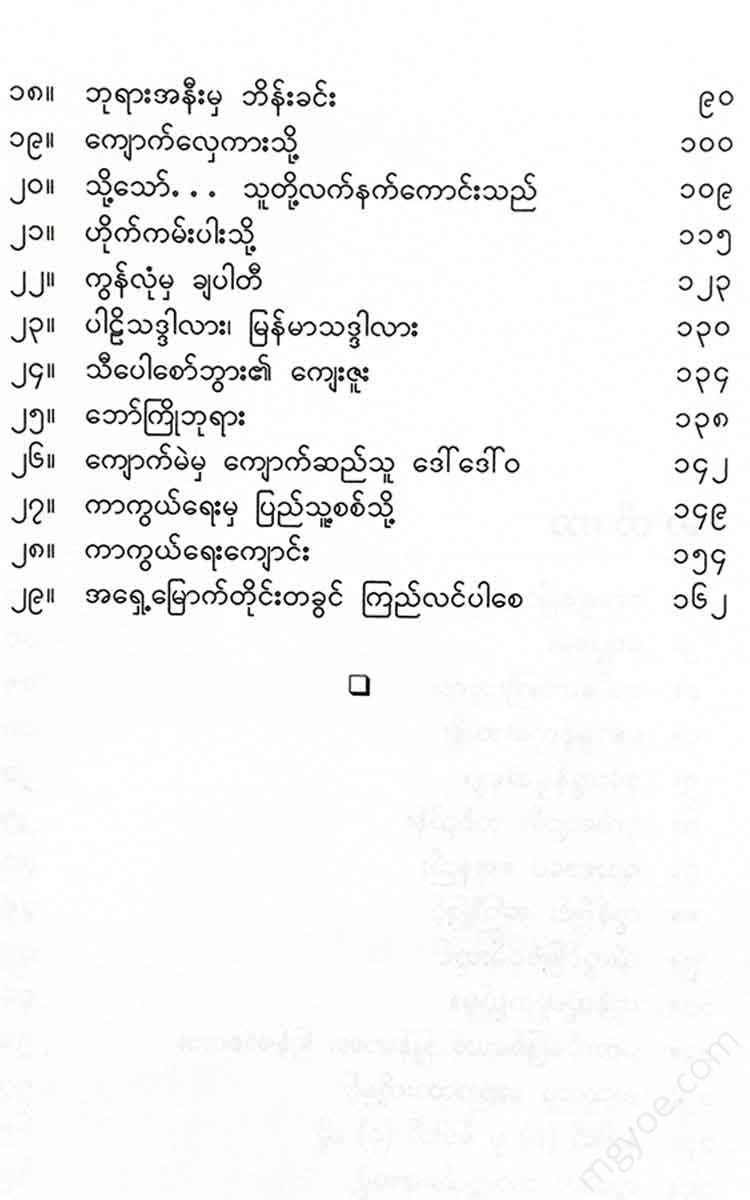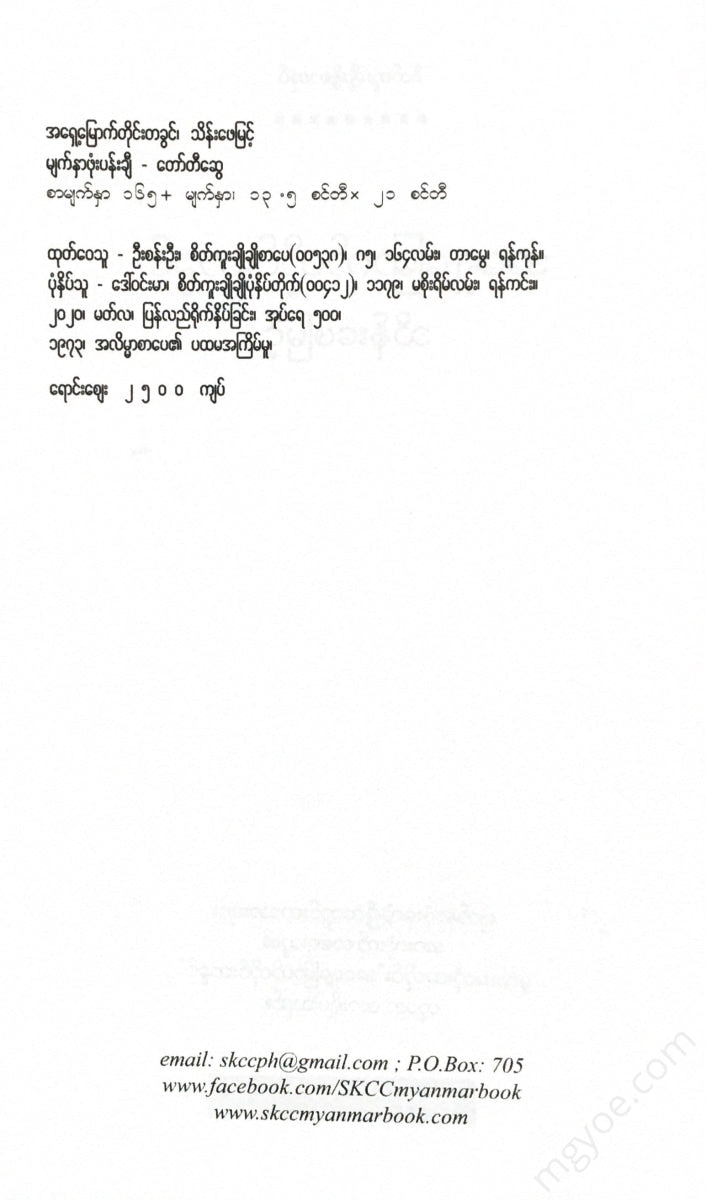စိတ်ကူးချိုချိုစာပေ
Thein Pe Myint - Across the Northeast Region
Thein Pe Myint - Across the Northeast Region
Couldn't load pickup availability
Throughout the Northeast
It seems like winter is late.
It's December 4th and it's not cold yet. It's not cold in Yangon, but it will be cold where we're going. So I brought plenty of warm clothes.
The plane stopped briefly at Loikaw and disembarked. I walked around the airport. It was not cold. I saw signs of recent rain.
After about half an hour, we arrived in Heho. Heho was also not cold. At Heho airport, we met an old friend, Mimi Khine (Mrs. Saw Simon). Mimi Khine, who had written a book about Burma in English, was a poultry farmer and was picking up a shipment of chicks that had been flown in from Yangon.
The Falcon 8 plane was landing in Mandalay from the Shan highlands. The sun was already high at Mandalay Airport, so it was not only cold, but also hot.
After flying over the Shan highlands for more than half an hour, we arrived in Lashio. Arriving from Yangon to Lashio
We parted ways with the Frenchman, saying our heartfelt thanks to the flight attendants who did nothing for the passengers except hand out sweets and pour each of us a cup of coffee, and who did not even explain the life-saving procedures in case of an emergency.
We are Phoe Kyaw Myint, a Myanmar language lecturer and writer. Among those who greeted us at the airport, I saw the film actor Ko Htun Wai, flashing his camera. He was waiting for me in Lashio, as we had planned to travel together on our “Northeast Region” tour. (Ko Htun Wai had already left before me and had already been to Loikaw and Maymyo.)
The people who welcomed me from Lashio were the doctor, the writer Kambawza Khin Hlaing, and some of the senior members of the International Book Year and Writers’ Day Committee. The chairman, Say Ao, was wearing loose Shan trousers and a shirt, so I assumed he must be a Shan man. The secretary, a woman with dark eyes and a dark complexion, was hard to distinguish.
Doctor Kambawza Khin Hlaing is also dark-skinned. He is tall and has a lively expression and facial features. No matter how he looks, his appearance, his nature, his attitude, or his ideas, he is a Shan-Burmese person.
Dr. Kambawza Khin Hlaing welcomed us as the Writers' Day Committee, and on the other hand, as the Director of the Regional Hospital, he welcomed the surgeon, Mr. Wright. In Bila, surgeons are not called Dr., but Mr., so he called them Mr. Wright. He was traveling to give advice as a surgeon under the Colombo Plan. In the morning, the time was wrong, so he could not take the first flight to Lashio, but came with us. Because of this time mistake, it was Dr. Kambawza Khin Hlaing who suffered the most, not Mr. Wright.
We arrived in Lashio around noon. The sun was shining brightly from a clear sky, but it wasn't too hot. The weather was cool and pleasant.
Kambawza Khin Hlaing took us to his newly built house. He didn’t live in that house, he lived in another house. The new house was like a guesthouse. When I was in Yangon, I heard from Kambawza Khin Hlaing, “When you arrive in Lashio, I will give you a house to stay in for free,” but I didn’t expect it to be so comfortable.
The guesthouse of Kambawza Khin Hlaing is a one-story building. However, it is built on a hill, so the balcony is two stories high. There is a place to park your car under the balcony. The hill is located on a fairly high part of Lashio, so from the balcony, you can see a wide view of the northeast, stretching to the horizon. It is a wide view of Lashio. It is green and lush.
I first came to Lashio in 1939. Lashio was so green then. But I don't remember it being so new. Lashio wasn't so big then, nor was it so beautiful.
The guest house of Kambawza Khin Hlaing is divided into two parts. One part is the living room and the other is the dining room. The dining room can accommodate a large group of people. The living room has shiny new and beautiful furniture. There are also cabinets filled with unusual jewelry and souvenirs. You can tell from the living room that the host is a lover of beauty.
Surrounding the main hall are a pagoda and five bedrooms. There are also two bathrooms. An additional room has been set aside for the kitchen.
After assigning us to our rooms, Kambawza Khin Hlaing showed me the pagoda room...
“If you want to worship, the temple is here,” he said. I said nothing, just nodded.
They had breakfast at around 1:00 PM. Then they rested until late afternoon.
When you come to Lashio, you know that the evening market is the place where everyone goes. If you go openly and are not suitable, you go in disguise. Military personnel do not go in uniform. Some people go because they want to shop. Some people go because they want to look. Some people go because they want to look. Some people go because they want to buy.
The market is open from 3pm to 6pm, so I call it the evening market. Some call it the black market. The people of Lashio just call it the market. Actually, the evening market should not be called the black market. They do not sell secretly at the evening market. They sell boldly and calmly at any market. There is no sign of any robbery at the evening market. There are no arrests.
The evening market is an open-air market located in the middle of the Lashio market. I have never seen such a complete range of foreign goods anywhere. The fabrics are not only various types of nylon, various types of silk, tetrahedron, pheasant, big and small waves, but also have a variety of patterns. There are not only beautiful fabrics and strong fabrics from the capitalist world from Thailand, but also socialist beautiful fabrics and strong fabrics from the People's Republic of China. The tailoring and clothing are also of various styles.
Various watches, various radios, various tape recorders, various pens, various medicines.
Large bottles, dishes, bowls, pots.
There are also many different types of cosmetics. You can even find hair dyes. They are sold with spray-on tools. In terms of toothbrushes, the socialist toothbrush is beating the capitalist toothbrush.
I saw red and black Johnny Wai, and when I asked the price, he said that the red one was 100 and the black one was 120. I saw a brandy called Tiger Yo Brandy from China, and when I checked it, it was a medicinal liquor made from a mixture of the spine and other Chinese herbal medicines. It said that it was eight kyats per bottle, so I bought the Tiger Yo Brandy, which is both an alcohol and a stimulant. I had come to the evening market just to look at the price. However, I did not buy much. The reason is that almost everything is expensive. Johnny Wai costs from 100 to 120 kyats per bottle, and a bottle of hair dye costs 25 kyats. When I asked Htun Wai, who was looking at the prices, he said that they were not far from Yangon prices. Some products were slightly lower than Yangon prices, while others were slightly higher.
However, the Lashio Night Market is said to be unique because of its variety of colors, variety of products, and the fact that you don't have to buy in bulk, and you can choose from a wide range of products. However, it is said that people who live in Lashio do not visit this market much, except for tourists. When asked whether it is because it is simple, boring, or expensive, the main reason is that it is expensive.
The evening market is bustling with activity. The vendors are mostly Chinese and Shan Chinese. Northern Shan State is a place where many ethnic groups live, so there are also other ethnic vendors. There are some genuine Shan and some genuine Burmese. But the Chinese and Shan Chinese dominate. The black traders that were seen in 1939 are no longer to be seen. The shoppers are also of various ethnic groups. Most of them come from the Ayeyarwady River basin. They buy and sell whatever they can.
As they walked through the market, at first, no one knew that Prince Htun Wai was there. Later, as everyone realized, they became agitated. People were walking around, looking at each other, people in front of them, and people running behind them. One of Htun Wai's qualities was that he was always looking at people. When people looked around, he didn't slouch, he didn't hunch, he didn't turn his face away, he didn't turn away, he did what he had to do. He said what he had to say. When he was shopping, he spoke Chinese, so the Chinese market and the Shan Chinese market were not only surprised, but also seemed to be impressed.
So, while we were walking around the evening market, Lashio reporter Ko Aung Min called us. Ko Aung Min's face was like that of college student Ne Win, which made him a point of interest to the market crowd. But it didn't take long for them to realize that he was actually Ko Aung Min, a native of Lashio. Ko Aung Min called us to watch the trucks arrive.
A large truck arrived at a place outside the open-air market. We ran to the side of the road and dodged it. It was a large passenger bus. It was packed with large packages of goods on the roof and inside. People were also crowded into the bus between the packages. There were very few men on the bus. There were only a few middle-aged women. When the truck stopped, the women got out, each carrying their own package. They had bought foreign goods from the border. They would sell them on the side of the road even when they were traveling. However, unlike the open-air market, they did not focus on retail sales. They focused on wholesale sales. When we saw large Chinese bedspreads, we asked the price and an older woman said 40 kyats per piece. When we thought it was the market, we decided to buy them. The second woman, who seemed more authoritative than the first woman, told us that the first woman had given a wrong price and that the correct price was 70 kyats. We turned around without buying anything. We went into a shop selling car parts and found both domestic and foreign parts.
There are even Chinese-made fan belts. It's an auto parts store that explains why there are so many old sedans and old buses and trucks circulating around this area.
Foreign goods are not only brought in by buses, but also by mules. Traders and market vendors, each group renting from 100 to 800 mules, trade across the border. As Myanmar exports goods, so do imports. In fact, this trade is carried out by the people.
We found that there is border trade. We will continue to study what goods are being sent from Myanmar.
After watching the truck arrive, we returned to the guesthouse. It was getting dark and cold.
When I investigated why they closed their shops after six in the evening, this is what I found.
The people who run the open-air market usually live on the outskirts of Lashio. They close their shops late at night, collect the money from the sales, and then return with the remaining packages of goods on their carts. They are often robbed on the street. They are afraid of this, so they close the open-air market after six o'clock.
